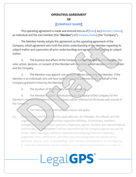Why IT Service Contracts Fail (And How to Write One That Works)
The small manufacturing company thought they had solved their IT headaches when they signed a comprehensive service contract with a local provider....
10 min read
LegalGPS : Oct. 27, 2025
When Sarah Martinez launched her digital marketing agency, she thought a handshake deal with her web hosting provider would suffice. Six months later, when her client's e-commerce site went down during Black Friday weekend, she learned why that 67% failure rate for service contracts isn't just a statistic—it's a business reality that costs entrepreneurs millions annually.


Legal GPS Pro
Protect your business with our complete legal subscription service, designed by top startup attorneys.
The difference between thriving businesses and those that crumble under service failures often comes down to one critical document component: Service Level Agreements (SLAs). These aren't just legal formalities—they're your business insurance policy against the unpredictable world of service delivery.
Most entrepreneurs enter service relationships with optimism and good intentions. Unfortunately, intentions don't protect your business when things go wrong. Industry research consistently shows that approximately two-thirds of service contracts fail to meet their original objectives, leaving businesses scrambling for solutions.
The financial impact extends far beyond the immediate service costs. When service providers fail to deliver, businesses face cascading consequences: lost revenue, damaged client relationships, and operational disruptions that can take months to recover from.
Consider the case of David Chen, who owned a boutique marketing firm in Austin. His contract with a cloud storage provider seemed straightforward—unlimited storage for $299 monthly. The contract mentioned "99% uptime" but provided no specifics about what that meant or what happened when they fell short.
When the provider experienced a week-long outage, David lost access to client campaigns worth $180,000. The provider's response? A credit for one month's service fee. David's clients, however, demanded compensation for their delayed product launches and lost advertising spend.
Without clear SLA terms, David had no legal recourse for the actual damages his business suffered. The "99% uptime" promise proved meaningless when he needed it most.
The root causes of service contract failures cluster around three primary areas: vague expectations, inadequate accountability measures, and poor communication frameworks. Understanding these failure points helps entrepreneurs protect their businesses before problems arise.
Vague language creates the perfect storm for disputes. Terms like "reasonable time," "best efforts," and "industry standards" sound professional but provide no measurable benchmarks for success or failure.
Before signing any service contract, apply the specificity test. If you can't explain exactly what the service provider must deliver, when they must deliver it, and what happens if they don't, your contract needs more detail. Specificity isn't nitpicking—it's protection.
Inadequate accountability measures represent another critical failure point. Many contracts establish what services will be provided but ignore what happens when those services fall short. This creates an imbalanced relationship where the service provider bears minimal risk for poor performance.
Communication breakdowns compound these issues. Without clear escalation procedures, response time requirements, and regular check-in protocols, small problems evolve into contract-ending disasters.
Michael Rodriguez hired a development team to create a customer portal for his consulting business. The contract specified "a fully functional customer portal" for $45,000 with a "summer delivery target."
By September, the portal remained incomplete. The developers claimed they were delivering what was contracted, while Michael insisted the product was unusable. Neither party was wrong based on the contract language, but both were frustrated.
The project eventually cost Michael $78,000 and took fourteen months to complete. A detailed SLA specifying functionality requirements, testing procedures, and delivery milestones could have prevented this expensive miscommunication.
Service Level Agreements function as the measurement and accountability framework within your service contracts. While your main contract establishes the relationship and basic terms, the SLA defines exactly how service quality will be measured and what happens when standards aren't met.
Think of SLAs as your service contract's GPS system. They tell you where you're going, how you'll know when you arrive, and what to do if you get lost along the way.
Effective SLAs contain three essential elements: specific performance metrics, clear measurement methods, and defined consequences for non-compliance. These elements work together to create a framework that benefits both parties by eliminating ambiguity and establishing mutual accountability.

Service Level Agreement
Use our Service Level Agreement (SLA) Template to define performance standards and service obligations. Essential for ensuring accountability, measurable outcomes, and compliance with client expectations and industry best practices.
Trusted by 1,000+ businesses to safeguard their LLCs.
Performance metrics should be measurable, relevant, and achievable. Instead of promising "fast response times," specify "initial response within 2 hours during business hours, 8 hours during weekends and holidays."
Measurement methods explain how performance will be tracked and who is responsible for monitoring. Will the service provider self-report metrics, or will you have access to independent monitoring tools? Transparency in measurement builds trust and prevents disputes.
Consequences for non-compliance create incentives for consistent performance. These might include service credits, penalty payments, or contract termination rights. The key is ensuring consequences match the severity of the failure and provide meaningful recourse.
Structure SLA consequences using a three-strike framework: minor failures trigger service credits, repeated failures invoke penalty payments, and systematic failures allow contract termination. This graduated approach encourages improvement while protecting your business from persistent poor performance.
Creating effective SLAs requires careful attention to several critical components. Each element serves a specific purpose in protecting your business interests while maintaining a fair relationship with your service provider.
Availability commitments define when services must be accessible and functional. Express these as specific percentages with clear definitions of what constitutes downtime. A 99.9% uptime commitment allows for approximately 8.77 hours of downtime per year—know what you're agreeing to.
Response time requirements establish how quickly the service provider must acknowledge and begin addressing issues. Distinguish between acknowledgment time (when they confirm receipt of your request) and resolution time (when they fix the problem).
Jennifer Walsh learned from other entrepreneurs' mistakes when selecting a cloud backup service for her legal practice. Her SLA specified 99.95% uptime (allowing only 4.38 hours of annual downtime), 15-minute response times for critical issues, and 4-hour resolution times for service outages.
When her primary server failed, the backup system activated automatically. The provider acknowledged the issue within 8 minutes and had full services restored in 2.5 hours. Because they met their SLA commitments, Jennifer's practice experienced no client-facing disruptions.
The SLA also included monitoring dashboards that Jennifer could access anytime to verify performance metrics. This transparency helped build trust and ensured accountability.
Performance quality standards go beyond just keeping services running. They define the acceptable parameters for service delivery, such as data transfer speeds, processing times, or accuracy rates.
Escalation procedures outline the steps for addressing problems when they occur. Who do you contact first? When should issues be escalated to management? What information must be provided at each level? Clear escalation paths prevent small issues from becoming major crises.
Regular reporting keeps you informed about service performance without requiring constant monitoring. Specify the frequency, format, and content of performance reports. Monthly reports work for most services, but critical services might require weekly or even daily updates.
Notification requirements ensure you're promptly informed when problems occur. Distinguish between planned maintenance (which should be scheduled with advance notice) and unexpected outages (which require immediate notification).
Change management procedures address how service modifications will be handled. Will you be notified before changes? Do you have approval rights for changes that might affect your business? How much advance notice will you receive?
Require advance notice equal to the potential business impact of changes. Minor updates might need 48 hours' notice, while major system changes should require 30 days. This gives you time to prepare contingency plans if needed.
Even well-intentioned SLAs can fail if they contain common structural mistakes. Understanding these pitfalls helps you avoid expensive learning experiences that have cost other entrepreneurs dearly.
Unrealistic expectations damage relationships and create unnecessary conflict. If your service provider typically resolves issues in 6 hours, demanding 2-hour resolution times will likely result in higher costs or rejected proposals.
Insufficient penalty structures fail to create meaningful incentives for good performance. Service credits that equal a few dollars for outages that cost your business thousands don't adequately protect your interests.
Tom Bradley's online retail business relied on a payment processing service with an SLA promising 99% uptime. When the processor experienced outages during peak shopping hours, Tom's business lost $23,000 in sales over three incidents.
The SLA penalty? A service credit worth $47 per incident. The disconnect between Tom's actual losses and the SLA remedies left him bearing almost all the financial risk of service failures.
Tom's replacement SLA included escalating penalties: 10% service credit for the first monthly failure, 25% for the second, and contract termination rights plus penalty payments for three failures in any six-month period.
Vague measurement definitions create disputes over whether SLA commitments have been met. Terms like "reasonable efforts" or "commercially reasonable" sound professional but provide no objective standards for evaluation.
Missing force majeure clauses fail to address how extraordinary circumstances will be handled. While you can't expect service providers to perform during natural disasters, you should know how such events affect your SLA commitments and what alternative arrangements will be made.
Poor monitoring provisions prevent you from verifying whether SLA commitments are being met. If you can't independently confirm service levels, you're relying entirely on the provider's self-reporting—a system that naturally creates conflicts of interest.
Specify what monitoring data will be collected, how it will be shared, and what tools you'll have access to. Real-time dashboards and automated reporting eliminate disputes over service performance.
Incomplete termination procedures create costly complications when relationships end. Your SLA should specify notice periods, data transfer requirements, and transition assistance obligations. Without these provisions, ending a service relationship can become expensive and disruptive.
Lisa Chen discovered the importance of termination procedures when switching accounting software providers. Her original SLA contained no data export requirements, leaving her previous provider free to charge $8,500 for data extraction and conversion services.
Her new provider's SLA includes specific data portability requirements: if the relationship ends, the provider must deliver data in standard formats within 10 business days at no additional charge. This provision protects Lisa's business regardless of why the relationship ends.
Successfully implementing SLAs requires a systematic approach that balances protection with practicality. The goal is creating enforceable agreements that serve your business needs without making service relationships unnecessarily complicated or expensive.
Start by identifying your critical business requirements. What service failures would seriously damage your business? How quickly do you need problems resolved? What level of communication do you require? Understanding your actual needs helps you focus SLA negotiations on what matters most.
Research industry standards for your specific service type. Hosting providers, software vendors, and professional services each have different typical performance levels. Knowing what's realistic helps you negotiate effectively without making unreasonable demands.
Approach SLA negotiations as problem-solving discussions rather than adversarial bargaining. Service providers want satisfied customers, and most are willing to commit to reasonable performance standards when they understand your business needs.
Focus on mutual benefits when proposing SLA terms. Explain how clear performance standards help you plan your business and reduce support requests. Frame penalties as incentives for excellent service rather than punishment for failure.
Consider offering performance bonuses for exceeding SLA commitments. A small bonus for maintaining 99.99% uptime when the SLA requires 99.9% creates positive incentives and demonstrates that you value exceptional service.
Present SLA discussions as partnership conversations: "Help me understand what performance levels you're confident you can maintain, and I'll explain what my business needs to be successful." This collaborative approach often yields better results than demanding specific terms.
Establish a phased implementation for complex SLAs. Begin with basic performance metrics and add more sophisticated measures as the relationship develops. This approach allows both parties to build confidence and refine the agreement based on actual experience.
Set regular review periods to evaluate SLA effectiveness. Quarterly reviews work well for most services, allowing adjustments based on changing business needs or service improvements.
Create clear documentation and training procedures for your team. Everyone who interacts with the service provider should understand what's covered by the SLA and how to escalate issues when problems occur.
Rachel Thompson implemented a comprehensive SLA strategy when outsourcing her law firm's IT management. She started with basic uptime and response time commitments, then added security monitoring and compliance reporting after three months of successful performance.
The phased approach allowed both parties to build trust and refine the agreement. By year's end, Rachel's SLA included advanced cyber security protections and disaster recovery procedures that would have been overwhelming to negotiate initially.
Regular quarterly reviews led to improvements like remote monitoring dashboards and automated alert systems. The collaborative approach turned a vendor relationship into a true partnership that enhanced Rachel's business operations.
While many SLA components can be negotiated by business owners, certain situations benefit from professional legal assistance. Understanding when to invest in expert help can save significant money and prevent costly mistakes.
Complex technology services often involve technical specifications that require legal expertise to properly structure. Cloud computing, software licensing, and managed services agreements contain nuances that can significantly impact your business if not properly addressed.
High-value contracts justify legal investment due to the potential financial exposure. If service failures could cost your business more than a few thousand dollars, professional legal review becomes a wise investment rather than an unnecessary expense.
Businesses in regulated industries face additional SLA complexities around compliance, data protection, and reporting requirements. Healthcare, finance, and legal services often require specialized knowledge to ensure SLA terms meet regulatory obligations.
Professional legal assistance helps navigate these requirements while maintaining practical enforceability. An attorney experienced in your industry can identify potential compliance issues and suggest protective language.
Certain contract terms should trigger automatic legal consultation. Limitation of liability clauses that cap provider damages below your potential losses require careful evaluation. Indemnification requirements that make you responsible for provider legal issues need professional review.
Intellectual property provisions affecting your data or work product deserve legal attention. If the service provider claims rights to your information or work created using their platform, understand the implications before signing.
Calculate the potential cost of service failures, then compare that to legal review fees. If service disruptions could cost your business $50,000, spending $2,500 on legal review is excellent insurance. The goal is proportional protection, not perfection.
For ongoing service relationships, consider annual legal check-ups to review SLA performance and suggest improvements. Markets change, technology evolves, and your business grows—your SLAs should evolve accordingly.
Service Level Agreements represent more than legal documents—they're strategic business tools that protect your operations while enabling growth. The 67% failure rate in service contracts isn't inevitable when you implement proper SLA protections.
Start by evaluating your current service relationships. Which providers lack clear performance standards? Where could service failures seriously impact your business? Prioritize SLA implementation based on risk and business impact.
Remember that effective SLAs benefit everyone involved. Service providers gain clear expectations and satisfied customers, while your business receives predictable service levels and protection against failures.
Your next step is taking action. Whether you're negotiating new service agreements or improving existing relationships, implementing proper SLA protections is an investment in your business's stability and growth.
The cost of proper SLA planning pales in comparison to the potential losses from service failures. Don't become another statistic in the 67% failure rate—use Service Level Agreements to build the reliable service foundation your business deserves.
For more guidance on protecting your business through proper contracting, explore Legal GPS's comprehensive template library and consider their Pro subscription for ongoing legal support as your business grows.

Legal GPS Pro
Protect your business with our complete legal subscription service, designed by top startup attorneys.
|
Premium Template
Single-use Template |
Legal GPS Pro
Unlimited Access, Best Value |
|
|
| Choose Template | Learn More |
| Trusted by 1000+ businesses | |
Table of Contents

The small manufacturing company thought they had solved their IT headaches when they signed a comprehensive service contract with a local provider....

If you're a business owner who's had a service project go sideways, you're not alone. Maybe your website redesign spiraled from $5,000 to $15,000....

The artificial intelligence revolution has arrived at your business doorstep, promising efficiency gains and competitive advantages that seem too...